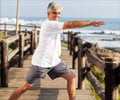Recent randomized controlled study compares efficacy of tai chi versus aerobic exercise in providing relief from fibromyalgia symptoms.
- Tai Chi mind body treatment offers better symptom relief in fibromyalgia according to recent study.
- Currently aerobic exercise is the most commonly recommended non-drug treatment in fibromyalgia.
- Fibromyalgia is a common condition marked by tiredness, widespread body pain and sleep disturbances affecting two to four percent of the population between 18 to 65 years globally.
Reason For Study
- Presently, moderate aerobic exercise is prescribed as part of standard care non-drug management of fibromyalgia symptoms.
- However, many patients are unable to do or to adhere to the prescribed exercise regimen due to fluctuations in symptoms, and remain unfit as a result.
- Also drug treatments have not been found to be very satisfactory.
- Therefore, newer approaches to treatment may be needed to help these patients with their chronic pain, psychological symptoms and to improve their quality of life.
Methods of the Study
For the current study, a randomized controlled trial was conducted by scientists at Tufts Medical Center, a tertiary care academic hospital in Boston, Massachusetts.- The study involved 226 participants with mean age of 52 suffering from Fibromyalgia (as defined by the American College of Rheumatology 1990 and 2010 criteria). Ninety two percent of patients were female and 61 percent were Caucasians.
- Participants were randomly assigned to one of five groups, namely
- One group to 24 weeks of supervised aerobic exercise twice a week or
- Four groups (different schedules) of either 12 or 24 weeks of yang-style supervised tai chi, once or twice a week
- 151 candidates were assigned to Tai Chi regimen and the remainder 75 to the aerobic exercise program.
- The primary outcome parameter measured was occurrence of visible change in the revised fibromyalgia impact questionnaire (FIQR) scores at 24 weeks compared to baseline symptoms.
- Other parameters (secondary outcomes) assessed included patient’s global assessment, self-efficacy, coping strategies, anxiety, depression, physical functional performance, limitation of activity, sleep, and quality of life.
Key Findings of Study
- All five groups showed symptomatic improvement of both primary and secondary outcomes measured
- Tai chi treatment groups showed greater benefit compared to aerobic exercise given in the same frequency for similar duration (24 weeks, twice weekly)
- The groups who did tai chi for 24 weeks showed much better improvements than those who received it for only 12 weeks i.e. dose dependent improvement
- There was no significant difference in benefit in the groups who were administered tai chi twice a week compared with once weekly
- Participants attended the tai chi training sessions more regularly than participants who attended aerobic exercise program i.e. tai chi treatment compliance was better
- The therapeutic effects seen with tai chi were more consistent across all instructors.
- No serious adverse events were reported due to any of these interventions
In conclusion this study strongly suggests that tai chi mind-body treatment offers better pain relief in fibromyalgia although tai chi as standard of care treatment may be difficult to incorporate across clinical settings due to practical limitations.
About Fibromyalgia
Fibromyalgia is a complex condition characterized by generalized chronic muscle and joint pain, tiredness, sleep disturbances, significant limitation in physical activities and psychological impairment, resulting in significant morbidity and increasing healthcare costs. It affects about 2-4% of the general population between 18 and 65 years globally.It is believed to be due to disordered pain regulation associated with neuroendocrine changes in the central and peripheral nervous systems.
Currently, there is no cure for fibromyalgia, and core treatments involve a multidisciplinary approach, including drugs and exercise, cognitive behavioral therapy, and health education.
Although drugs offer modest short-term relief, several patients discontinue treatment due to lack of efficacy, intolerance or adverse effects due to the drug.
About Tai Chi
Tai chi is an ancient exercise form rooted in traditional Chinese medicine that began as a martial art and has been practiced for several centuries. This complex, multisystem mind-body intervention aims to integrate physical, psychosocial, behavioral and spiritual elements to promote health and fitness.Reference:
- Chenchen Wang, Christopher H Schmid, Roger A Fielding, William F Harvey, Kieran F Reid, Lori Lyn Price, Jeffrey B Driban, Robert Kalish, Ramel Rones, Timothy McAlindon, "Effect of tai chi versus aerobic exercise for fibromyalgia: comparative effectiveness randomized controlled trial." BMJ (2018); 360 DOI: https://doi.org/10.1136/bmj.k851
















